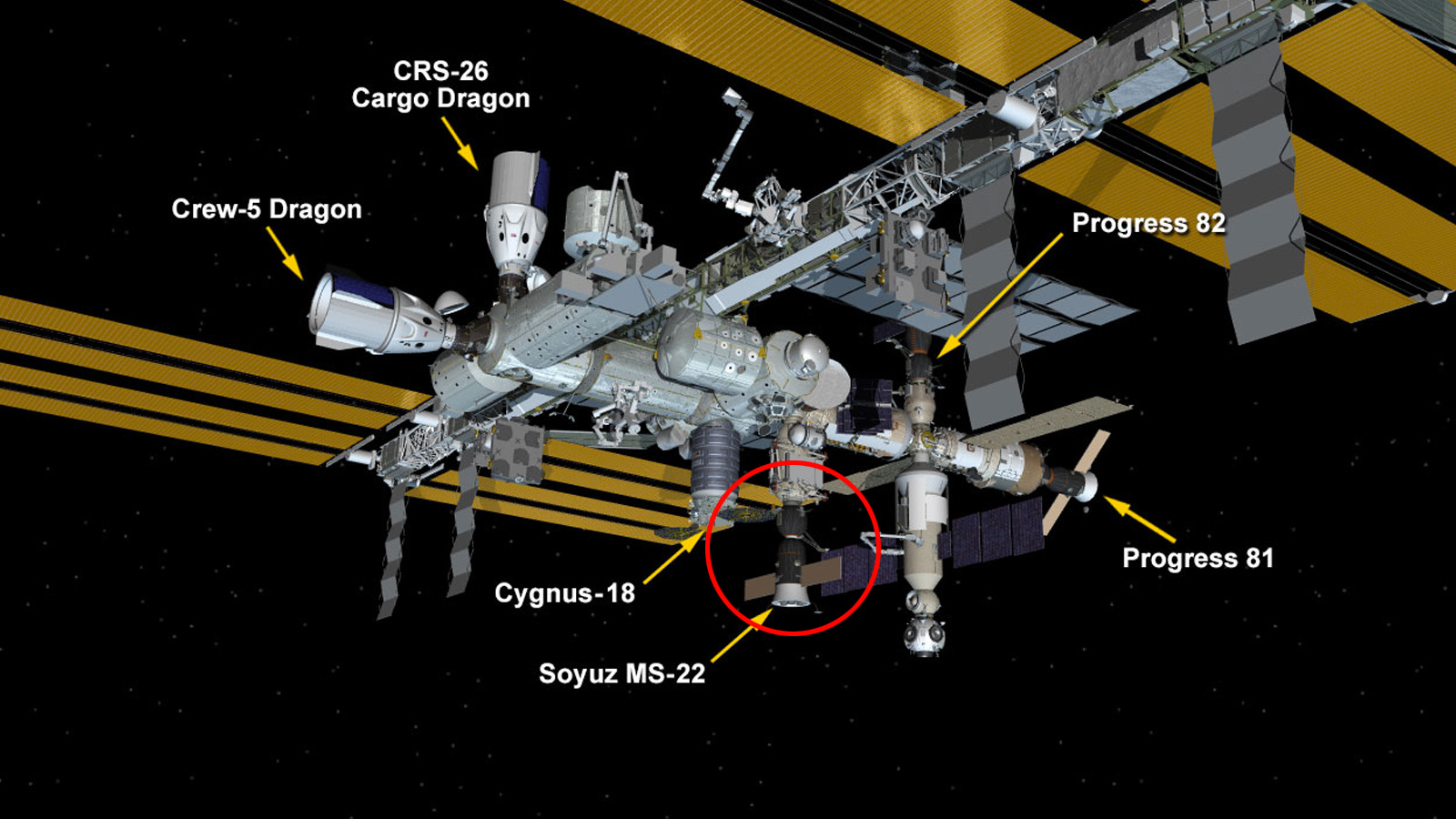The spacecraft in question is the Soyuz designated MS-22, one of the two spacecraft that are always docked to the ISS, acting both as ferries to the station from Earth, and, when docked, acting as a way back home, both for scheduled returns and in case of emergencies. A Soyuz can carry up to three crew, and with the current complement of seven crew on the station (four came up and can return in the SpaceX Crew Dragon spacecraft) a working Soyuz is needed to provide safe evacuation of all crew.
The Soyuz has been spraying out some sort of frozen flakes for hours; the particles were determined to most likely be coolant coming from one of the Soyuz’ external cooling manifolds, two of which make up part of the spacecraft’s single coolant circulation loop, which includes a radiator that wraps around the aft section of the service module. Pressure sensors in the cooling loop showed low readings, and despite the leak, currently the Soyuz’ temperature is within acceptable limits.
A spacewalk was scheduled but was cancelled when the leak was discovered, to prevent astronauts and cosmonauts from being potentially covered in spraying coolant. The Canadarm2 robotic arm was tasked to get closer video footage of the leak to try to determine its source. Here’s some NASA footage of the leak in action:
That’s a hell of a leak! It’s not clear just yet what caused it, though a micrometeorite strike is a possible explanation. The humble Soyuz has the longest and safest track record of any crewed spacecraft, so this is a very unusual situation. No one has died in a Soyuz since the Salyut 1/Soyuz 11 tragedy of 1971 when a faulty valve opened during reentry, causing the crew of three to suffocate after their successful mission to humanity’s first space station, Salyut 1. While the ISS crew isn’t in immediate danger, if this Soyuz is found to now be unusable for re-entry, Roscosmos will need to launch an uncrewed Soyuz and dock it to the station remotely to replace the damaged Soyuz, which would be a first for the ISS. A spacewalk is planned for December 19, and the Soyuz will be inspected remotely to determine what the plan is. We’ll update when NASA and Roscosmos figures out what they want to do, which probably won’t include some JB Weld, duct tape, and a stern warning to not leak, ya bastard.
Coverage Of The Chinese Rocket That’s Crashing Back To Earth Gives Me Hope That The VW Beetle Is Still A Universal Unit Of Measurement Russia Says They’re Pulling Out Of The ISS Yet Again So Let’s Look At What This May Mean Got a hot tip? Send it to us here. Or check out the stories on our homepage. Support our mission of championing car culture by becoming an Official Autopian Member. I think Nulon really needs to expand their “Ya Bastard” product line: For coolant leaks: Stop Leak’n Ya Bastard! Car wash: Ya Filthy Bastard! Transmission fluid: Shift Ya Bastard! Brake fluid: Stop Ya Bastard Conduction? Not really. Everything is in contact with everything, and its all being heated by the sun. Convection? Nope. No molecules in contact to allow heat transfer away Radiation? Uh-uh. That’s what’s heating it up, sun’s radiation. Not going to be able to cool with that bastard beaming down on ya. Insulation helps, blocking the sun’s rays definitely helps, the rest is done with radiators. IIRC the key is to orient the radiators perpendicular to the sun. I suppose one could also use the shadow of the solar panels or other structures. You can’t have a coolant leak if you have no coolant to leak! Ah Kirk, my old friend. Do you know the Klingon proverb that tells us revenge is a dish that is best served cold? It is very cold in space. Why Soviet Pilots Called It “The Booze Carrier”: The Tupolev Tu-22 Story https://www.youtube.com/watch?v=bKoHMXggEHU


